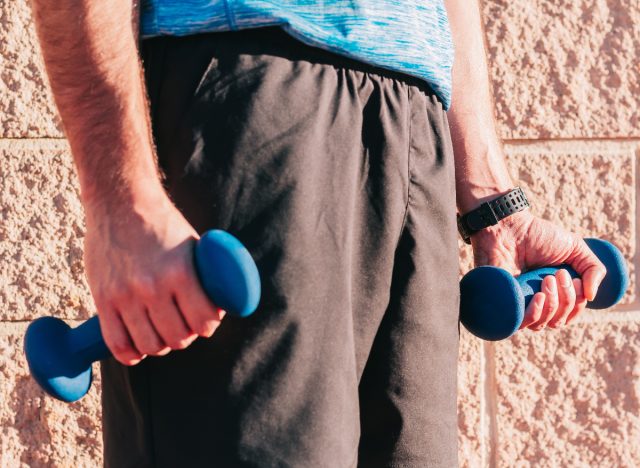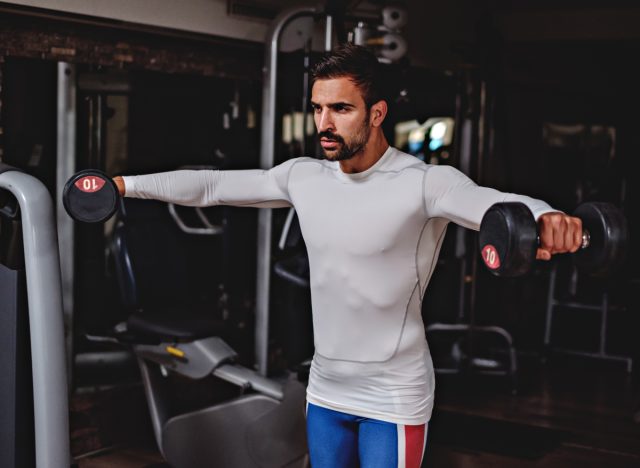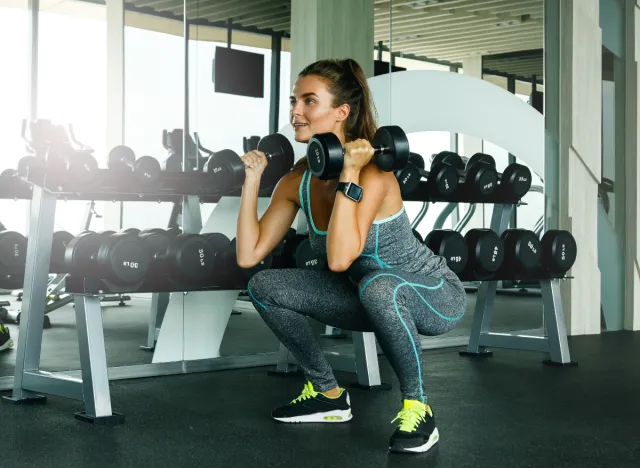If you’ve ever used a gym or shopped around for fitness equipment, you’re likely familiar with dumbbells. Dumbbells offer many advantages as a method for strength and muscle building, including their ease of use for beginners and a wide range of exercise options. Despite this, I commonly see people make mistakes when working out with dumbbells that hurt their gains and limit their overall fitness results.
That’s why today, I’ll walk you through the five absolute worst mistakes you’re making when working out with dumbbells. In addition, I’ll discuss some basic steps to avoid them to maximize your fitness gains. Keep reading to learn more, and next, don’t miss Over 50? Here Are 6 Exercise Mistakes You’re Too Old To Make.


When lifting dumbbells, you should use a weight that feels heavy for you when performing that exercise for eight to 12 repetitions. I far too commonly see clients performing sets of 20 or more repetitions using very light dumbbells, thinking the “burn” they feel by rep 35 is leading the greater improvement. Unfortunately, that’s not just the case.
To see real muscle growth and strength gains, the repetitions need to be low and heavy. For most of your dumbbell exercises, you should hit failure by 12 repetitions or lower, depending on the specific goal within your workout program. Closer to 12 is better for muscle, while closer to three to five repetitions is better for maximal strength. In either case, the weight needs to be relatively heavy.


Dumbbells allow you to isolate specific muscles very effectively, especially in the arms, such as biceps curls and triceps extensions. While there is a place for isolation movements in your fitness program, your best results will come from focusing on compound movements such as overhead presses and rows, which hit multiple muscle groups, allow you to lift more total weight, and more closely mimic functional movements in daily life.


Dumbbells allow a much greater range of motion than barbells because your wrists, forearms, and shoulders can rotate relative to one another when lifting dumbbells. To get the most out of your dumbbell training, include the full range of motion by going through a full rotation with your arms.
For example, instead of overhead pressing, starting with your palms facing forward, begin with a neutral grip on the dumbbells, your palms facing each other, and rotating your hands outward as you press the dumbbells up. In this case, you give your shoulder a more natural range of motion while increasing the total working range of the exercise.
READ RELATED: Supriya Annaiah Height, Weight, Age, Facts, Biography
Other examples include rotating the dumbbells from neutral to prone grip when flat bench pressing or rowing.


Dumbbells are great for hitting your upper body, but many people ignore dumbbells as a tool for lower body strength and muscle building.
You can use dumbbells to perform weighted squats with a goblet-hold position, front-rack position, or held at your sides. You can do the same for lunges as well. Performing single and double-leg deadlift variations with dumbbells is also very feasible. Finally, you can easily add a dumbbell to your lap to perform weighted glute bridges for some highly-targeted glute work.
To put it simply, don’t skip leg day just because you only have dumbbells.


The last of these mistakes you’re making when working out with dumbbells has to do with trying to combine cardio and weights. Group fitness classes and other activities often use dumbbells as a form of cardio training. While this isn’t the worst thing in the world, dumbbells are a tool for strength and muscle building. Trying to break a sweat and maintain an elevated heart rate over an extended period by using light dumbbell movements is not an efficient or effective way to train and can risk muscular strain.
I recommend using strength exercisers when training strength, and picking a traditional cardio modality such as running, swimming, cycling, or other sport to hit your aerobic needs. If you absolutely insist on using dumbbells for cardio, be sure to incorporate them into a HIIT-style training program.
Tyler Read
Source:








